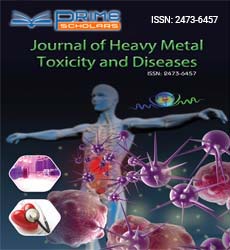Short Communication - (2023) Volume 8, Issue 1
Innovating of Chelation Therapy for Cardiovascular Diseases
Daniela Silvestrini Fernandes*
Department of Chemical Science, University of Sao Paulo, Brazil
*Correspondence:
Daniela Silvestrini Fernandes,
Department of Chemical Science, University of Sao Paulo,
Brazil,
Email:
Received: 02-Jan-2023, Manuscript No. IPJHMCT-23-15537;
Editor assigned: 04-Jan-2023, Pre QC No. IPJHMCT-23-15537 (PQ);
Reviewed: 17-Jan-2023, QC No. IPJHMCT-23-15537;
Revised: 23-Jan-2023, Manuscript No. IPJHMCT-23-15537 (R);
Published:
30-Jan-2023, DOI: 10.21767/2473-6457.23.8.004
INTRODUCTION
EDTA is an intravenous chelating specialist with high fondness
to divalent cations (lead, cadmium, and calcium) that might be
advantageous in the treatment of cardiovascular illness. Albeit
a huge randomized clinical preliminary showed benefit, more
modest investigations were conflicting. We directed an efficient
survey of distributed examinations to look at the impact of rehashed
EDTA on clinical results in grown-ups with CVD. It’s indistinct
whether chelation treatment can treat coronary illness.
Description
Chelation treatment has for quite some time been utilized as a
treatment for mercury and lead harming, yet it’s anything but
a demonstrated treatment for coronary illness. It might possibly
cause serious secondary effects when utilized as a coronary
illness treatment. All things being equal, some medical services
suppliers have utilized chelation treatment to treat coronary illness
and stroke. Chelation treatment includes week after week
IV medicines of ethylenediaminetetraacetic acid. Every treatment
goes on around 30 minutes. By and large, the prescription
searches out and sticks to metals and minerals in the circulatory
system, making a compound that the body eliminates while peeing.
Chelation treatment is advanced as a treatment for coronary
illness since it’s imagined that the medication sticks to calcium
tracked down in greasy stores (plaques) in the supply routes.
Chelation treatment for coronary illness has known dangers and
secondary effects. The most widely recognized is consuming
at the IV site. Opposite aftereffects incorporate fever, cerebral
pain, sickness or spewing. Uncommon however serious entanglements
of chelation treatment for coronary illness that have
been accounted for include: Low blood-calcium levels (hypocalcaemia),
unexpected drop in circulatory strain, drop in bone
marrow counts (bone marrow concealment), cardiovascular
breakdown, Kidney harm, demise. Lead is a harmful ecological
poison, considered one of the most bountiful xenobiotic metals.
The fundamental wellsprings of openness are tainted water, air,
food, or soil. Lead is many times obtained through word related
openness, fastened joints in water pipes, airborne discharges,
lead-containing food items and the notable toxic paints. Once
consumed, over 90% of lead is collected in the bone. The lead
put away in bone can stay for a long time and be delivered years
after the fact into the circulatory system, long after openness.
Blood lead levels are the typical strategy for testing for harmfulness;
however they just reflect late openness. As a matter of fact,
the degrees of blood lead have been falling consistently since
leaded gas for street driven vehicles was disposed of. Be that as
it may, ecological openness proceeds, and the cardiovascular results
are not limited to high, on-going openness levels. Cadmium
is a very poisonous metal that plays no natural part in people.
Battery-powered batteries represent most of cadmium modern
use by and by. What’s more, their protected removal stays a test.
A few plants, natural products, and grains can energetically ingest
cadmium from the dirt as well as water, making one more
wellspring of human openness and harmfulness. Tobacco plants,
for instance, eagerly take up cadmium in the leaf. Thus smoking
is the main single wellspring of cadmium openness in everyone.
Chelation treatment, a program of rehashed intravenous organization
of ethylene diamine tetraacetic corrosive, frequently given
in blend with nutrients and minerals, has been promoted as a
protected elective treatment for atherosclerotic vascular sickness.
As this is a non-customary treatment, there is no generally
perceived standard convention. Most conventions, in any case,
share a level of likeness. There is a huge group of writing to help
the utilization of EDTA in the treatment of cardiovascular illness;
nonetheless, by far most of the writing depends on uncontrolled
proof. The discoveries of this efficient survey ought to bear some
significance with clinicians and patients the same [1-5].
Conclusion
The utilization of EDTA by patients as a treatment for cardiovascular
illness and as an assistant or option in contrast to a medical procedure isn’t upheld by the greatest of proof. Taking into
account the expense caused by patients who use EDTA chelation
treatment and the potential for hurt related with any intravenous
mediation including the potential for antagonistic impacts
inferable straightforwardly to EDTA, clinicians ought to ask about
understanding use and feature the absence of proof to help its
utilization.
Acknowledgement
None.
Conflict of Interest
The authors declare that they have no conflict of interest.
References
- Pirkle JL, Schwartz JE, Landis JR, Harlan WR (1985) The relationship between blood lead levels and blood pressure and its cardiovascular risk implications. Am J Epidemiol 121: 246-258.
[Crossref] [Google Scholar] [PubMed]
- Navas-Acien A, Selvin E, Sharrett AR, Calderon-Aranda E, Silbergeld E, et al. (2004) Lead, cadmium, smoking, and increased risk of peripheral arterial disease. Circulation 109: 3196-3201.
[Crossref] [Google Scholar] [PubMed]
- Tellez-Plaza M, Guallar E, Howard BV, Umans JG, Francesconi KA, et al. (2013) Cadmium exposure and incident cardiovascular disease. Epidemiology 24: 421-429.
[Crossref] [Google Scholar] [PubMed]
- Tellez-Plaza M, Jones MR, Dominguez-Lucas A, Guallar E, Navas-Acien A (2013) Cadmium exposure and clinical cardiovascular disease: A systematic review. Curr Atheroscler Rep 15: 356.
[Crossref] [Google Scholar] [PubMed]
- Agarwal S, Zaman T, Tuzcu EM, Kapadia SR (2011) Heavy metals and cardiovascular disease: Results from the National Health and Nutrition Examination Survey (NHANES) 1999–2006. Angiology 62: 422-429.
[Crossref] [Google Scholar] [PubMed]
Citation: Fernandes DS (2023) Innovating of Chelation Therapy for Cardiovascular Diseases Mine. J Heavy Met Toxicity Dis. 8:004.
Copyright: © 2023 Fernandes DS. This is an open-access article distributed under the terms of the Creative Commons Attribution
License, which permits unrestricted use, distribution, and reproduction in any medium, provided the original author and source
are credited.

